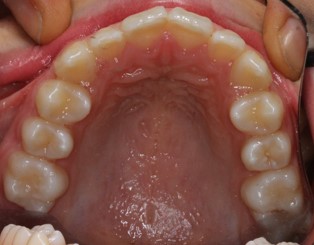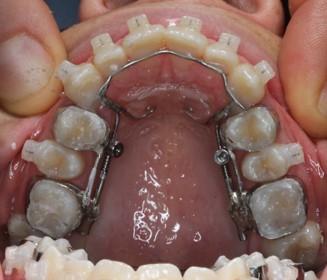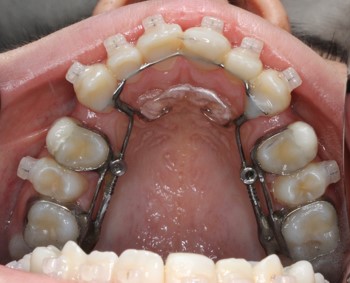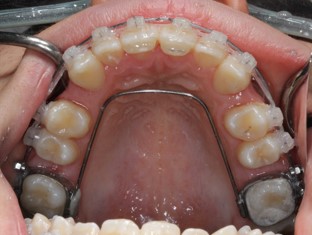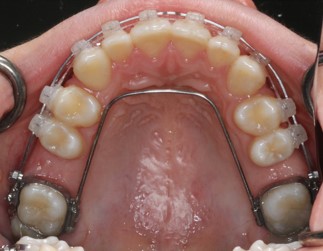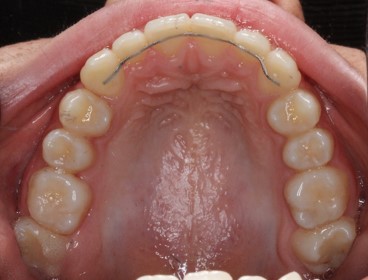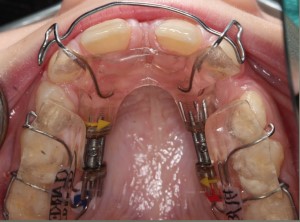In my 30 years of practice, the growth guidance appliance is arguably the most significant appliance I have used. The upper arch (maxilla bone) is one of the most important bones in the body as it determines the position of the lower jaw, which in turn may affect the airway and the TMJ joints.

The good news is that it is never too late to treat patients with underdeveloped maxillae. It is generally accepted that orthodontic treatment without extracting any teeth is the way to go, although like most things, there are always exceptions.
Many people are now aware that expansion of the dental arches is widely practised by dentists and orthodontists. There are numerous dental expanders and generally they all work well. But most do not expand anteroposteriorly (maxillary advancement), which is most important to resolve some or all of the issues described above. Maxillary advancement will create more space for the tongue and will facilitate improvements in airway, TMJ pain and aesthetics. Note that in regards to aesthetics, the appliance will do more than straightening teeth, it will also improve the person’s profile.
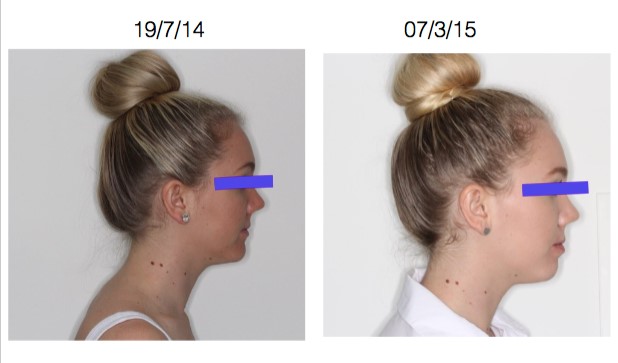
The picture on the left above shows the photo prior to commencement of treatment. The picture on the right shows the picture after the completion of the FAGGA appliance. Note the improvement of the patient’s profile and posture. Usually, the maxillary advancement takes four to six months.
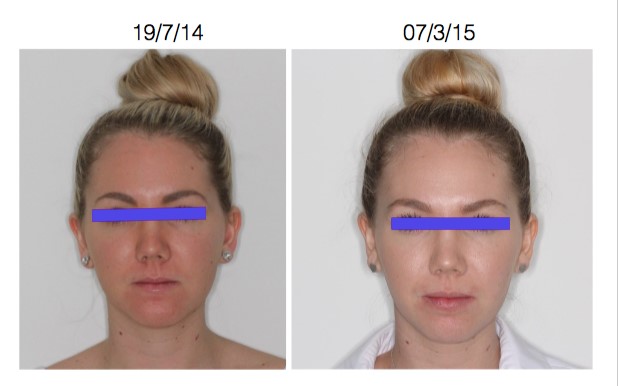
The picture on the left above shows the photo prior to commencement of treatment, note the lower jaw shifts to the left. The picture on the right shows the picture after the completion of the FAGGA appliance. Note improvement of the lower jaw, which is more symmetrical after treatment.
This Is How We Do It
There are two different types of anterior growth guidance appliances, the fixed and removable. The fixed appliance (FAGGA) is designed for adults and the removable (RAGGA) is designed for children.
FAGGA (Fixed Anterior Growth Guidance Appliance)
The fixed appliance cannot be taken out, the patient comes in for simple adjustments every four to six weeks. The upper arch expands anteriorly (to the front) by approximately 1 mm a month as can be seen by the pictures below. Note the spaces created between the upper canines and the first premolars behind.
Once the desired spaces are achieved, the appliance is removed and a lingual wire (FRLA) is inserted inside the mouth to avoid relapse, ie we want to make sure that the teeth do not collapse back to the original position.
Initial photo |
29/9/14 FAGGA insertion |
1/12/14 2 months after FAGGA insertion |
3/1/15 3 months after FAGGA insertion |
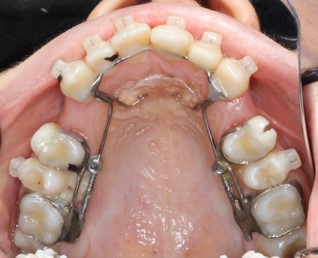 |
We will then place braces on both upper and lower teeth. The braces with the help of elastic bands will move the back teeth forward to close the gaps, while maintaining the position of the front teeth. This procedure will also enhance the chance of all wisdom teeth erupting in the correct position, without the need for extractions.
In the meantime, the lower braces will straighten the lower teeth. Once all the gaps are closed, the upper and lower teeth are coordinated to ensure optimal aesthetics and function.
8/2/15 Four months after FAGGA insertion |
4/4/15 Premolar teeth are being pulled forward |
17/6/15 Now it’s the molars’ turn to be pulled forward |
The end result is an expanded upper jaw both towards the front and the sides. The jaw will be able to accommodate all permanent teeth (may include wisdom teeth if the conditions are right) to erupt in the correct position, the lower jaw is able to occlude into the ideal bite in harmony with the TMJ joints and the facial muscles. The ensuing enlarged space in the mouth allows the tongue to position itself correctly against the roof of the mouth, opening up good airways at the back of the throat and inside the nose.
Fees for both FAGGA and braces vary from $7500.00 to $10,000.00 depending on the complexity of the case. Please note that the fees are generally higher than the fees for regular braces (usually $5500.00 to $7500.00). The FAGGA appliance improves the airway, profile and the TMJ joints, it does more than just straightening teeth. RAGGA (Removable Anterior Growth Guidance Appliance)
The removable appliance is for designed for children to accommodate the orofacial growth (usually under 10 years old). The appliance is turned (activated) twice a week by the patients themselves, or for the very young ones, by their parents. It is to be worn 24/7 including eating. The appliance does a similar function as the FAGGA in the growing mouth, it expands the upper jaw in all dimensions, to lay down the foundation and to accommodate the eruption of the incoming permanent teeth. When the permanent teeth are ready to erupt down there will be adequate amount of space. In most cases, braces are still required to complete the final alignment and the coordination of the upper and lower teeth. However, due to the presence of the already prepared spaces, the treatment time for the braces may only take six to nine months.
RAGGA on a model |
RAGGA six months after activation (note amount of spaces created) |
Before the treatment commences we also assess the airway and determine if there is an airway obstruction, we may then refer patients to the ENT surgeon. If there is a sign of obstruction due to mucus build up in the nasal cavities, we may send the patient to an allergist. If there is a dysfunctional habit, such as tongue thrusting we may send the patient to a myologist.
Fees for RAGGA is $3000.00-$3500.00 (first phase). When all the baby teeth have come out, the braces will usually be required to straighten the teeth, the fee is $3000.00 to $3500.00 (second phase).
Do You Need The Growth Guidance Appliance?
We will need to take your records such as x-rays/photos and study models. These records usually cost $300.00 and are claimable if you have a Health Fund.
From the records, we will assess the position of the upper jaw and your profile from the photos. If the records determine that the patient is midface deficient, then the growth guidance appliance will be recommended. If there is only mild or no midface deficiency, only braces or no treatment is required.
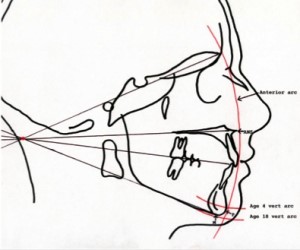
Lat Ceph x-ray analysis. Courtesy of Josh Jefferson
Risks of FAGGA and braces
The FAGGA is worn for four to six months. When the desired expansion is achieved, fixed braces and FRLA (inside wire) will be inserted for approximately nine to 15 months. Risks associated with the FAGGA include:
- Gingival recession
- Nonvitality (teeth may die)
- Speech impediment during the course of treatment
- Ulceration of tongue, lips and cheeks
- Root resorption (roots become shorter)
- Part(s) of appliance may debond
Risks associated with braces include:
- Gingival recession
- Nonvitality (teeth may die)
- Speech impediment during the course of treatment
- Ulceration of tongue, lips and cheeks
- Root resorption (roots become shorter)
- Brackets debonding (coming off)
